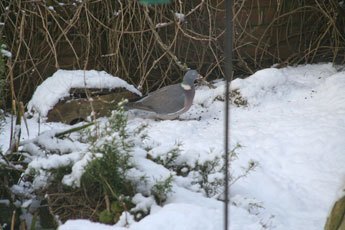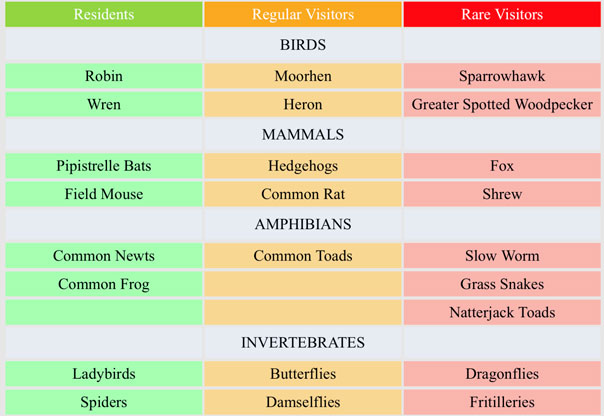Projects
We have a number of ongoing projects which you can access by clicking on the heading.
- Re-introducing Indigenous Wildlife
- Expeditions
- Wildlife Gardens
- Nestboxes
- Monitoring
Wildlife Gardening and Animal Feeding Station
(WAFS)
The Wildlife Gardening and Animal Feeding Station Programme (WAFS) is a project that can be used in a number of ways by almost all organizations and individuals, including householders. A fuller account of how to make and use a site can be seen in the published articles (Conserving Wildlife. no 11).
 |
| Millstream Fork in snow; Woodpigeon and Dunnock near the Toad House. |
|---|
 | Acrobatic squirrel almost guaranteed success |
 |
| Parakeets - if you're lucky. |
WAFS
- WAFS needs a specially designated area set aside for wildlife, such as the first pilot project at Millstream Fork. In schools, WAFS can be used in many ways which suit the staff and children:
- WAFS can be used as a formal educational project in the classroom
- WAFS can be used informally by schools as 'extra mural studies'
- WAFS can be used for educational play.
- Children can become champions, prefects, angels or guardians of animal feeding, ornithology, monitoring or making reports.
- Certain flowers can be planted with an aim to attract specific animals. One example is by planting herbs to attract butterflies.
- Children can also express themselves with creative writing.
 |
| Damselfly - many colours are possible with a pond. |
|---|
In the past;-
FES made WAFS a UK UNESCO ASPnet pilot project.
FES put WAFS into Nepal for the first time.
The WAFS Prototype Project
WAFS initial pilot project is a small piece of land at the back of the FES registered office which was changed from a family horticultural garden in the 1980s. The area had been typical of a small urban garden.
"The Secrets of Millstream Fork" is a set of articles published in magazines which record many of the animals which have been seen at the Foundation for Endangered Species' registered office over the last 35 years. Many of these articles will appear in an anthology by the Wildlife Zone.
Some features of a Wildlife Garden (and its environ) could include;-
- A moving water pond
- A still water pond
- An alpine rockery and flower beds.
- Climbing plants that covers walls and fences
- Herbs and special flowers in pots and tubs, and/or an area specially set aside for them (such as a raised garden).
- A lawn.
- Man made items put into the site to increase biodiversity include;-
- Bird tables
- Animal feeding poles
- Bird boxes
- Bat boxes
- Ladybird and Lacewing boxes
- Frog and Toad houses
- Mini-beast habitats (including a hibernacuium)
- These can include simple throw-away things, such as an old carpet or a piece of corrugated plastic.
Ideally a new WAFS should begin with an 'environmental audit', however informal it may be. This is because it will show what is there at the beginning of the project. As you make plans and create changes, differences of the flora and fauna can be monitored and then assessed. It is always best to assess the garden's surroundings and environment in order to maximize biodiversity, including resident animals and visitors. By doing so, the site can be inexpensive to set up and develop. Moreover, the garden could become low-maintenance and largely ecologically sustainable. With care and attention, it could also be beautiful, although in truth, some wildlife gardens may seem untidy and unkempt.

There are some features of the Millstream Fork site which may well be unacceptable to schools wildlife areas because of health and safety issues for children. These include, allowing large wasp nests in situ, large ant colonies, deep water ponds, and stinging nettle patches.
Here is one example of how to categorize some garden animals found in a wildlife garden.
The generic tables can be changed and adapted to use in the following circumstances:-
a. For diurnal and nocturnal creatures
b. For Spring, Summer, Autumn and Winter seasons
c. to specialise in particular groups such as butterflies, moths or birds.
It is worth remembering that rare animals can be very interesting and exciting, although they are not necessarily as beautiful as the ordinary or more common creatures that we usually see.
It is worth considering that some garden animals such as goldfish can be extremely beautiful, although they are a breed, and not a naturally occurring species. Moreover most fish species will eat other wildlife such as froglets, toadlets and newt fry. So decide on what you want in your wildlife garden before you commit and spend your money.

